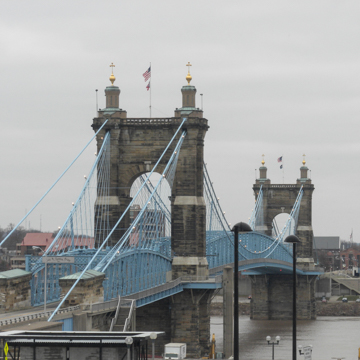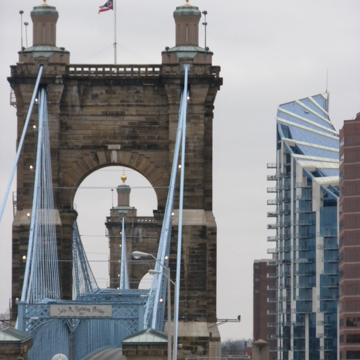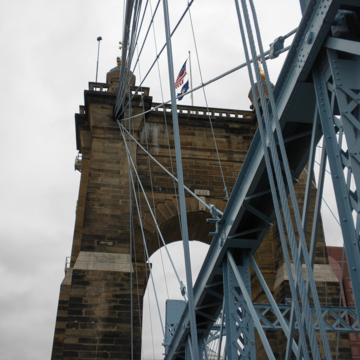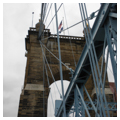You are here
John A. Roebling Suspension Bridge
When the John A. Roebling Suspension Bridge opened to foot traffic in December 1866, its 1,057-foot span made it the longest suspension bridge in the world. And while the bridge is a defining feature of the Cincinnati, Ohio, skyline, it is actually owned by the Commonwealth of Kentucky and lies within that state’s boundary, which runs along the northern edge of the Ohio River.
As early as 1846, the Covington and Cincinnati Bridge Company set about building a bridge across the Ohio River and selected John A. Roebling for the job; Roebling had successfully built a suspension railroad bridge over the Niagara River in 1851. Roebling’s 1,200-foot span with 100 feet of clearance would have allowed for the easy continuance of steamboat traffic even in high water but this first plan was rejected by the Ohio legislature. The bridge charter was taken up once again in 1854 and Roebling was officially contracted. Construction began in September 1856, continued sporadically throughout the Civil War, and was completed in December 1866. Roebling's bridge brought the thriving industrial cities of Covington and Cincinnati into closer and more regular contact than ever before.
For all of their extraordinary strength, the iron wire suspension cables look spidery and fragile, a feature that Roebling exploited by juxtaposing them against the massive Romanesque Revival masonry towers and anchorages. The towers on both the Covington and Cincinnati sides of the bridge were constructed simultaneously. Unsatisfied with available technology, Roebling devised his own square displacement pumps that ran off of tugboats on the river. The work crews were thus able to quickly reach the gravel riverbed, on which they laid thirteen layers of massive oak timbers, each set perpendicular to the one beneath and all bolted with iron hardware and cemented into place. Over this, massive blocks of sandstone encased in limestone rose to a level of 25 feet, above which the final 205 feet of the towers were constructed of rough-hewn or rusticated sandstone. Heavy buttresses flank the round arches, which are themselves delineated by voussoirs and a keystone. Anchorages on both shores were constructed of rough-hewn limestone, in which eleven-ton iron anchors are linked to wrought-iron chain links of Roebling’s devising (and patent).
Wire for the suspension cables came from Richard Johnson’s mill in Manchester, England. The first wire “ropes” were laid in September 1865. Unwound from a spool resting atop a barge, the wires were allowed to sink to the river bottom and then were raised in unison and locked onto the anchorages. A total of 10,360 wires were eventually wound together and wrapped in an outer layer of cables composed of 5,180 wires each. Diagonal stays fanning from each tower and iron Howe trusses were added above the deck to increase the load capacity; the lattice-like trusses that span the roadway at regular intervals create a marvelous telescoping effect from either end of the bridge. Three hundred wrought-iron beams supported an oaken floor across which two streetcar tracks were laid. In 1896 the original deck was replaced with a wider steel deck and a second set of main cables were added to increase the weight limit to 30 tons (since reduced to 11 tons). The Suspension Bridge was first painted its distinctive light blue in 1896. Streetcar service was halted in the late 1950s.
The Commonwealth of Kentucky purchased the Suspension Bridge from the Covington-Cincinnati Bridge Company in 1953. It was designated a National Historic Civil Engineering Landmark in 1983, the same year it was renamed the John A. Roebling Bridge.
References
Armstrong, James B., "The Covington and Cincinnati Suspension Bridge,” Kenton County, Kentucky. National Register of Historic Places Inventory–Nomination Form, 1975. National Park Service, U.S. Department of the Interior, Washington, D.C.
Writing Credits
If SAH Archipedia has been useful to you, please consider supporting it.
SAH Archipedia tells the story of the United States through its buildings, landscapes, and cities. This freely available resource empowers the public with authoritative knowledge that deepens their understanding and appreciation of the built environment. But the Society of Architectural Historians, which created SAH Archipedia with University of Virginia Press, needs your support to maintain the high-caliber research, writing, photography, cartography, editing, design, and programming that make SAH Archipedia a trusted online resource available to all who value the history of place, heritage tourism, and learning.











